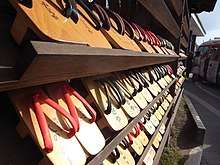Kinosaki
Kinosaki (城崎;) is an onsen(hot spring) town in the Kansai region of Japan, and now part of the city of Toyooka.
Understand

Kinosaki (also referred to as Kinosaki Onsen) is one of the earliest onsen towns in Japan. The first hot springs came into use in the 8th century and it has been a well known onsen destination ever since. It is said that storks were seen healing their wounds in the hot spring waters, and the Kinosaki hot spring water have been known for its healing qualities ever since.
Get in
The two most common routes of access start in Kyoto and Osaka/Himeji.
- The JR Hamakaze Limited Express runs from Kinosakionsen station to Himeji station, where you can jump back on frequent Shinkansen trains passing by. It is also possible to travel this route in segments using
- The JR Hashidate leaves from Nijo station in Kyoto to Kinosakionsen station. Again, this journey can also be made in segments on local trains.
There are also daily buses from Osaka to Kinosaki, but the train journey is much more comfortable and scenic, and is the recommended mode of transportation.
There are coin lockers in the station, and the hotel information center in front of the station can also keep your luggage for a fee.
Get around
The town can and should be covered by foot. If you are simply feeling too relaxed make the stroll to the next bath house, you can also hail one of the few taxis in town.
There are also excellent running trails near the main river in town - the Murayama river. Running along the river and among the rice paddies makes for a nice change of pace if you are feeling too guilty lazing around in hot springs all day long.
See
Do
The main attractions in Kinosaki are the public bath houses. There are seven of them:
- Satono-Yu (さとの湯). It is the first bathhouse that you see when exiting the train station. It is also one of the biggest, offering gender-separated indoor and outdoor baths, along with generous relaxation areas. There are also free footbaths right outside, highly recommend after a long day of walking or simply to pass time while waiting for the next train. The outdoor baths offer a beautiful view of the Murayama river and the surrounding rice paddies, it is not to be missed.
- Jizo-yu (地蔵湯). It is located inside an interesting concrete building with roomy ceilings and offers both public baths and rentable private baths as well.
- Yanagi-yu (柳湯). Only opens in the afternoon (3pm), so it is best to plan a few visits to the other bathhouses first. Its waters are said to be especially helpful for healing wounds.
- Ichino-yu (一の湯). It is praised as the best bathhouse in Japan. Its architectural style and well thought out decoration make it a popular and as a result, very busy bathhouse that is very popular with tourists.
- Goshono-yu (御所の湯). It is perhaps the prettiest out of all seven bathhouses. The traditional garden and facade welcomes you into both indoor baths and very elaborate outdoor baths, that are especially fascinating with snowfall.
- Mandara-yu (まんだら湯). With architecture inspired from temples, the bath might remind you of the mighty Buddhist temples that you saw in Kyoto, although at a much smaller scale. This is another bathhouse that opens late (3pm).
- Kono-yu (鴻の湯). This is the bath where the legendary storks bathed in the waters to heal their wounds. It is the most down key, but also the most relaxing public bath house.
Eat, kick back and soak, then eat more. If you've come to this town for something other than relaxing, you came to the wrong town!
Buy
- Local handicrafts
- Your own yukata to stand out among the crowds
- Hand-made snacks and refreshments from the many stalls around town
Eat
- Kinosaki is very well known for its seafood, especially crabs. You will often be served in-season seafood if you are staying in one of the many ryokans, or you can try one of the few restaurants around town, most of which focus on seafood. Be warned that many restaurants close very early, so make time to eat dinner a bit earlier than usual if you do not stay at a ryokan where dinner is included.
Drink
There are not many izakayas in the main stretch of town. It is more common to buy cold bottles of beer to be enjoyed after a soaking session or while walking in-between the bath houses. Ryokan will also serve alcohol.
Sleep
It is highly recommended that you stay in one of the many traditional and wonderfully maintained ryokans while in Kinosaki. Standard ryokan rates include breakfast and dinner, but you can also find certain ryokans that offer the room only to reduce costs, as most ryokans are not cheap.
Hotels are available in the area, but transportation to and back from the town can be an issue if you are not driving.
Connect
Go next
- Kami
- Shinonsen
- Yabu
- Tottori
- Asago
- Kyotango
- Amanohashidate
- Yosano
- Fukuchiyama